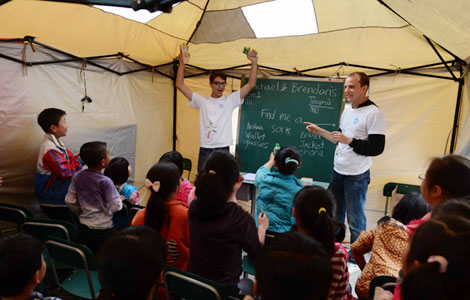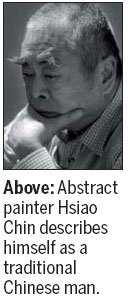Ground strokes
Updated: 2012-03-30 07:39
By Mariella Radaelli (China Daily)
|
||||||||
|
A painting of Hsiao created in 1988. |
Shanghai-born abstract artist continues spiritual quest from Milan
The abstract painter Hsiao Chin has lived in Milan for 63 years, yet he still considers himself profoundly Chinese.
"Now I am a Westerner, but still very Chinese," he says in his apartment on the fourth floor of a late Liberty-style building. "But not a contemporary Chinese. The younger generation is attracted to the most superficial things of the West. I am a traditional Chinese man, and I am glad to see today's Chinese over 50 rediscovering Confucianism and Taoism."
His artistic career spanning more than six decades has been a continuing spiritual search. Born in Shanghai on Jan 30, 1935, Hsiao's vision has become more certain with age, a journey of artistic phases redolent with the introspective richness of Eastern philosophies and religions. It is a contemporary rethinking of the lessons of Lao Tzu and Buddha.
His art has been shown in countless solo and group exhibitions, and important retrospectives across Europe, Asia and the United States.
"Painting to me is about diverting attention inwards. Metaphysics is central to my art, a revealing medium to realize myself," Hsiao says. His only aim is to "get to the essence - life is so brief to throw it away".
Capturing the metamorphoses - the continual changing of form and circumstances - is the eternal challenge. When achieved, it offers a sense of totality, order and repose, he says.
|
|
Lively and direct, with a warm childlike gaze of wonder and a good sense of humor, Hsiao is both modest and driven.
"I dreamed of being a pianist and a composer when I was a kid. But I was five when I lost my father. And we were so poor. He only left us a rare collection of musical instruments. My mother had to sell them to survive," he recalls. "Entering Shanghai Conservatory of Music you are welcomed by a view of the piano that belonged to my father."
Hsiao's father was an important cultural figure in 20th century China. Hsiao Yu-mei founded the first Chinese Conservatory of Music in 1927. "In China he opened the door to the world of classical Western music, to its eternal beauty.
"I remember him as a very disciplined man. He had a German character. He embodied Immanuel Kant's quote 'Man must be disciplined, for he is by nature raw and wild'.
"And in this sense I am like my father. He touched and made a difference in so many lives, as a director and as a teacher. He was a visionary leader, an innovator and a dedicated humanist - he could restore the use of his students' fingers that had been turned numb by freezing cold."
Music is also fundamental to Hsiao's work, part of a holistic framework for life. "My paintings have inner music," he says. "There are rhythms and vibrations I hope to transmit."
Baroque music is his favorite. "Bach and Corelli are on the top of my list. But I also love Renaissance composers like Monteverdi, and from the Romantic period, Chopin. As a child, I kept listening to Beethoven because I felt very alone."
A Hsiao painting is a kind of compressed musical moment that captures an interchange between the temporal and spatial. Repetition and variation, always a touchstone in his work, bring a sense of music to mind as well.
Hsiao's mother died when he was only 10 years old. He moved to Taiwan with his uncle in 1949, where he studied in Taipei under the guidance of master Li Chun-shen. "He emphasized the unity of heart, hand, eyes and the brain. And especially he taught me how to combine colors."
His early works had a Fauvist palette - hot red colors, the energy of different wavelengths, pervade his paintings. In 1956 he founded the first Chinese abstract movement, the Ton-Fan Art Group, in Taipei. The same year, a scholarship allowed him to travel to Europe as a student. His first stop was Madrid, then Barcelona. He was about to settle in Paris when, in 1958, the Milanese art gallerist Spazio Marconi offered him a contract. Marconi still represents him today.
In 1958 he visited the Venice Biennale at the beautiful lagoon. Viewing the wealth of artwork on show, he decided to live in Italy. "The country gave me a new lease on life. If I had stayed in France, I am pretty sure I couldn't have lived on art. Italians are good hearted people; they always bring something positive, like good wine."
In the 1960s he found himself at the center of the Italian avant-garde. With maestros Lucio Fontana, Piero Manzoni and Roberto Crippa, and his friend Antonio Calderara, he created Punto, an art movement that places the idea of the finite within the context of infinity. Simple in principle, but not minimalist, his art is rich in complexity of a sort that, once recognized, seems to pour forth with the intensity of revelation. It suggests a boundless space filled with poetry, however austere the geometry he sometimes uses.
Spots are Hsiao's hallmark, but how did he find his own signature? "Once in Europe, I couldn't emulate European painters. From the beginning, I never wanted form for form's sake. I needed to discover my own thinking beyond colors, lines and patterns. And this open-endedness seems to derive only from ancient Chinese culture."
Hsiao still flies to Taiwan twice a year. He has disciples there, and the Taiwan market for contemporary art is dynamic. In 1958 he began the Dao series that made his name and assured him a niche in art history. In the decades that followed, he continued working in series, including the Zen series (1974-80) and the Chi series (1981-90).
Hsiao recalls the event that marked the latest change in his evolving artistic style: the death of his daughter by his first wife, a Sicilian painter. It was a trauma that left him unable to paint for seven months.
"I loved Samantha so much. She was 23, and a student of painting at the Brera (the Accademia di Belle Arti, where Hsiao taught).
"After her departure to the spirit world, I met (Indian spiritual guru) Sai Baba and he pacified me. Death is not extinction; I believe in reincarnation. An individual is a soul that is an imperishable and evolving ego. We incarnate over and over. We live many lives and store up much experience. And the oldest souls have the quality of a genius. Think about Leonardo or Mozart."
To memorialize Samantha, he created his Passage Through The Great Threshold series (1991-95). Then "after despair, a light came carrying a new hope", he says.
He has pondered the mysteries of life throughout his career. "My father was agnostic, while my mother, the daughter of a protestant priest, was a very devoted Christian. And she succeeded in converting my father on his deathbed."
In his early Milanese years, Hsiao attended groups that studied theosophy and Rudolf Steiner while he practiced yoga and tai chi as an amateur. Spiritual but not religious, he is not a part of any church.
China Daily

 Relief reaches isolated village
Relief reaches isolated village
 Rainfall poses new threats to quake-hit region
Rainfall poses new threats to quake-hit region
 Funerals begin for Boston bombing victims
Funerals begin for Boston bombing victims
 Quake takeaway from China's Air Force
Quake takeaway from China's Air Force
 Obama celebrates young inventors at science fair
Obama celebrates young inventors at science fair
 Earth Day marked around the world
Earth Day marked around the world
 Volunteer team helping students find sense of normalcy
Volunteer team helping students find sense of normalcy
 Ethnic groups quick to join rescue efforts
Ethnic groups quick to join rescue efforts
Most Viewed
Editor's Picks

|

|

|

|

|

|
Today's Top News
Chinese fleet drives out Japan's boats from Diaoyu
Health new priority for quake zone
Inspired by Guan, more Chinese pick up golf
Russia criticizes US reports on human rights
China, ROK criticize visits to shrine
Sino-US shared interests emphasized
China 'aims to share its dream with world'
Chinese president appoints 5 new ambassadors
US Weekly

|

|









